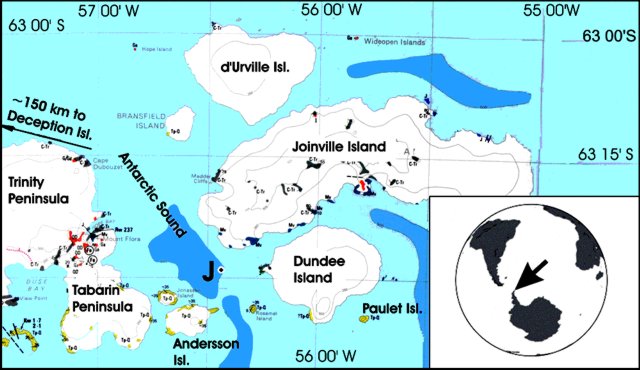Report on Additional Reports (Unknown) — March 2005
Bulletin of the Global Volcanism Network, vol. 30, no. 3 (March 2005)
Managing Editor: Richard Wunderman.
Additional Reports (Unknown) Antarctic Continental Shelf: Newly described submarine volcano (Jun Jaegyu) near the tip of the Antarctic Peninsula
Please cite this report as:
Global Volcanism Program, 2005. Report on Additional Reports (Unknown) (Wunderman, R., ed.). Bulletin of the Global Volcanism Network, 30:3. Smithsonian Institution. https://doi.org/10.5479/si.GVP.BGVN200503-600500
Additional Reports
Unknown
Lat Unknown, Unknown; summit elev. m
All times are local (unless otherwise noted)
Jun Jaegyu is a young volcano near the Antarctic Peninsula visited in May 2004 by researchers from a group of United States and Canadian universities aboard the U.S. National Science Foundation research vessel Laurence M. Gould (Cruise LMG04-04). The expedition's chief scientist was Eugene Domack of Hamilton College.
Prior to this cruise, bathymetric swath maps from 2002 revealed a symmetrical volcano that had not been scoured by the advance and retreat of glaciers. The 2004 cruise dredged the volcano and found material that included fresh basalt in a flank area devoid of colonizing bottom-dwelling organisms. In contrast, observations suggested that other portions of the volcano were heavily colonized by bottom-dwelling organisms. The discovery of the volcano corroborated mariners' reports of discolored water in the area. These observations, and a thermal anomaly, were all consistent with comparatively recent volcanic activity.
The volcano is located on the Antarctic continental shelf in the southern Antarctic Sound, ~ 9 km N of the easternmost point of Andersson Island and NW of Rosamel Island (figure 1), N of the mapped boundary of Late Cenozoic volcanic rocks. Swath bathymetric mapping indicated that the volcano stands ~ 700 m above the seafloor (at a depth of ~ 1,000 m) and thus extends to within ~ 275 m of the ocean surface. The seamount has an elongate, symmetrical shape and contains ~ 1.5 km3 of volcanic rock.
Two observed positive thermal anomalies (up to 0.052°C), recorded by temperature probes towed over the volcano from S to N, may be associated with two active volcanic centers. The more complex N temperature anomaly may also be associated with what appeared to be fresher lava flows.
The volcano lies along a NW-SE oriented fault scarp. Material dredged from the volcano have not been dated because accurately dating vesicular, partially altered, young submarine basalts is problematic at best. No gas samples were collected during this cruise.
Ashley Hatfield, a participant in the cruise and an undergraduate geology student at Hamilton College, advised by David Bailey and Eugene Domack, analyzed representative samples for whole-rock major and trace elements using XRF (X-ray fluorescence spectroscopy) and ICP-MS (inductively coupled plasma mass spectrometry). The samples are generally angular, glassy, and vesicular, having plagioclase, olivine, and clinopyroxene present as phenocryst phases, and with small rounded xenoliths being common (Hatfield and others, 2004). The samples were classified as alkali basalts and trachybasalts, and their chemical signatures were consistent with other known volcanoes throughout the northern Antarctic Peninsula.
Hatfield noted that the volcano is named in honor of Jun Jaegyu, a young Korean scientist who lost his life during the 2003 field season in the South Shetland islands. He was participating in the Korean Antarctic Program through their geophysical observatory based in the South Shetland Islands (King Sejong Station, established in 1988 on the Barton Peninsula, King George Island at 62°13.4818'S, 58°47.4744'W).
The scientific crew for this cruise included Hatfield, Bailey, and Domack, (Department of Geology, Hamilton College, Clinton, New York); Stefanie Brachfield, (Department of Earth and Environmental Sciences, Montclair State University, Upper Montclair, New Jersey); Robert Gilbert (Department of Geological Sciences, Queen's University, Kingston, Ontario); Scott Ishman (Department of Geology, Southern Illinois University, Carbondale, Illinois); Gerd Krahmann (Lamont-Doherty Earth Observatory of Columbia University, Palisades, New York); and Amy Leventer (Department of Geology, Colgate University, Hamilton, New York).
Reference. Hatfield, A., Bailey, D., Domack, E., Brachfeld, S., Gilbert, R., Ishman, S., Krahmann, G., and Leventer, A., 2004, Jun Jaegyu volcano; A recently discovered alkali basalt volcano in Antarctic Sound, Antarctica: Eos, Transactions, American Geophysical Union, 85(47), Fall Meeting Supplement, Abstract T11A-1248.
Geological Summary. Reports of floating pumice from an unknown source, hydroacoustic signals, or possible eruption plumes seen in satellite imagery.
Information Contacts: David G. Bailey, Eugene Domack, and Ashley K. Hatfield, Department of Geosciences, Hamilton College, 198 College Hill Rd., Clinton, NY 13323, USA.


